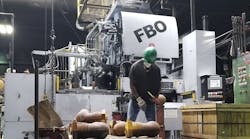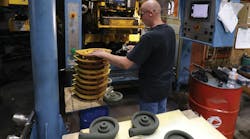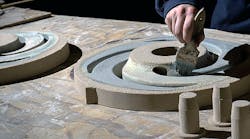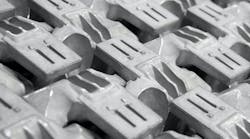In August Hoosier Pattern Inc. will become North America’s first commercial supplier of 3D-printed sand molds and cores when it inaugurates a new S-Max 3D, developed by The ExOne Company and acquired recently by the Decatur, IN, operation.
The S-Max 3D system dispenses foundry-grade resin into 0.011-in.-thick layers of specially engineered sand according to patterns derived from CAD data, building up layers to produce molds and cores that are dimensionally accurate and uniform. The “additive manufacturing” process also is fast, reducing lead times, and flexible: Hoosier Pattern indicated it will be able to customize and modify mold designs to improve casting performance, reduce weight, or add complexity to castings. It also said it would be able to offer rapid prototyping for concept designs.
The S-Max provides one of the largest workspaces available through additive manufacturing, a “build envelope” measuring 70.9x39.37x26.56 in. for building molds and cores. Hoosier Pattern indicated the large envelope presents the option to build cores and molds that it had been unable to supply using its CNC machines.
Hoosier Pattern’s Steve Murray explained that the 3D printing “is not an answer to every casting or foundry tooling problem, but it does fulfill a niche that has needed filling for some time.
“Engineers who need parts with no draft can now make them,” the additive manufacturing manager elaborated. “Get a sample casting before you invest in expensive tooling.”
He emphasized that customers needing a pattern quickly would have a realistic option of accomplishing their tight delivery schedules by initiating a 3D printing project.
Multiple Options
Murray then listed a series of other production needs that might encourage foundries to pursue 3D printing: “Molds to simulate production molding before expensive tooling is made and corrected,” he began.
“Molds to make prototype castings before foundry tooling is made … Molds to prove out designs … Cores that will not need assembly, and so will not have internal fins in the casting.
“Cores can be produced with no draft,” he continued, “to reduce casting weight, or (we can) make cores with hollow passages for gas to escape. Designers are now free to have castings made that do not have their designs compromised by manufacturability.”
Hoosier Pattern also expects to offer an economic advantage to foundry customers: “When you consider the cost of conventional tooling, it is actually cheaper,” Murray proposed. “The more complex the part, coupled with lower number of castings required makes this process stand out as the common sense answer. Complex cores that need assembly can be made as one piece. Any core can be made with a hollow for gas escape, or for core collapse. Achieving better internal passage quality of castings is a big plus.”
The decision to adopt 3D printing was essentially a competitive strategy for Hoosier Pattern. As a job shop, it was not directed to the production technology by any particular customer, nor are there any qualifying requirements for customers seeking to have a pattern produced by 3D sand printing.
“We are leading our customers and industry to this solution of better quality and faster turnaround of castings,” Murray explained. This helps customers make just what they want, and when. Pattern storage becomes a thumb drive. Changes can be made with no tooling charge. This is revolutionary for prototype casting and people that have legacy service parts.”









